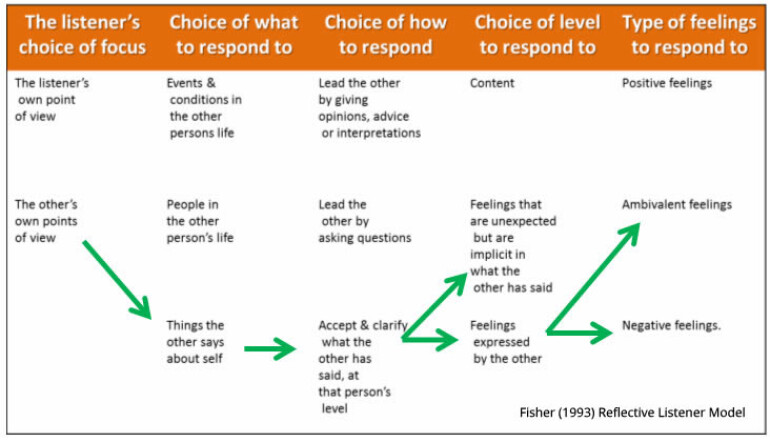Advanced Reflective Listening – toolkit to reflective feelings work using Fisher’s Reflective Listening Model.
Dalmar Fisher, an Associate Professor at Boston College, developed a model for Reflective Listening that includes the following elements:
- Actively engaging in the conversation, by reducing or eliminating distractions of any kind to allow for paying full attention to the conversation at hand.
- Genuinely empathizing with the speaker’s point of view. This doesn’t mean agreeing with the speaker, just viewing things from his/her perspective. The listener encourages the person to speak freely, by being non-judgmental and empathetic.
- Mirroring the mood of the speaker, reflecting the emotional state with words and nonverbal communication. This calls for the listener to quiet his mind and fully focus on the mood of the speaker. The mood will be apparent not just in the words used but in the tone of voice, in the posture and other nonverbal cues given by the speaker. The listener will look for congruence between words and mood.
- Summarizing what the speaker said, using the listener’s own words. This is different than paraphrasing, where words and phrases are moved around and replaced to mirror what the speaker said. The reflective listener recaps the message using his own words.
Advantages of Reflective Listening
Used appropriately, reflective listening may provide three very positive results:
1) The listener gains information. Reflective listening encourages the speaker to talk about more things in greater depth than he or she would be likely to do in simply responding to directive questions or suggestions. Such depth of discussion often exposes underlying problems, including ones the speaker had not recognized previously.
2) The relationship between the two persons develops. The elements of listening orientation –empathy, acceptance, congruence, and concreteness — are likely to increase as the reflective listening process continues. These are the ingredients for an open, trusting relationship
3) The activity arouses and channels motivational energy. Because the listener is an accepting and encouraging partner but leaves the initiative for exploring and diagnosing the problem mainly up to the speaker a normal outcome of the process is that the speaker will recognize new avenues for action and will begin making plans to pursue them.
Some Dangers to Avoid
1) Stereotyped Reactions Constantly repeating a phrase like “you feel that…” or “you’re saying that…”
2) Pretending Understanding If you get lost, say “sorry, I didn’t get that. What are you saying?”.
3) Overreaching Ascribing meanings that go far beyond what the other has expressed such as by giving psychological explanations or by stating interpretations that the other considers to be exaggerated or otherwise inaccurate.
4) Under-reaching Repeatedly missing the feelings that the other conveys or making responses that understate them.
5) Long-windedness Giving very long or complex responses. These emphasize the listener’s massive effort to understand more than they clarify the other person’s point of view. Short, simple responses are more effective.
6) Violating the other person’s expectations Giving reflective responses when they are clearly not appropriate to the situation. For example, if the other person asks a direct question and obviously expects an answer, simply answering the question is often best. In other words, if someone says: “what time is it?” you don’t usually say “You’re feeling concern about the time”.

